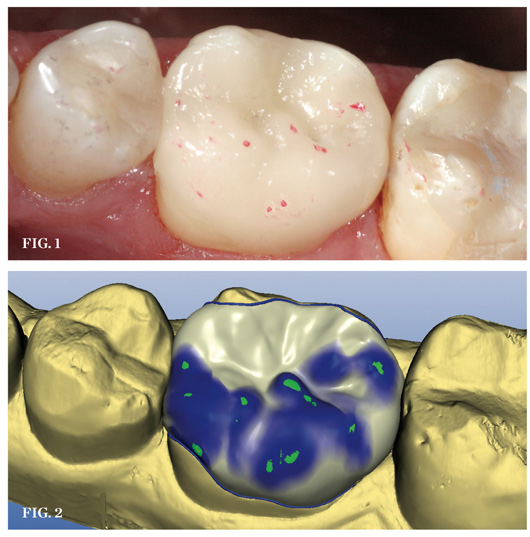CEREC® Biogeneric Software
Easily and precisely reconstruct natural occlusion.
Until now, designing CAD/CAM dental restorations required the dentist to apply a certain degree of manual shaping, forming, and sizing of various restoration aspects using a multitude of software “drawing” tools. Essentially, the software would propose a restoration to fit the intended space, but the proposals weren’t perfect “as is.” Rather, they needed more work before they could be milled and seated. And that finalization step—perfecting of the proposal on-screen before milling—required the dentist to step out of the role of dentist and become a graphic artist.

Dentist or Graphic Designer?
While not a tremendously tedious or overly demanding task, perfecting the final design of a restoration proposal (particularly the occlusal scheme) always came with a learning curve. For the practitioner, it meant having to learn when, why, and how to apply a myriad of graphic editing tools. Depending on the complexity of the restoration, this manual editing step could take a significant amount of time in an effort to get the restoration proposal finalized and verified. Most of this time is spent on occlusal adjustments, as the occlusal surface form is paramount to proper function.
The “Old Way” vs the New Biogeneric Way
Currently, all occlusal design approaches are based on limited libraries and databases containing data records of various standard teeth. Conventional CAD/CAM programs retrieve a matching tooth from the archive, and then generate a design proposal for the given clinical situation. The clinician then manually edits and adapts this proposal. No objective principles exist to justify this selection, and using matching databases can be subjective and time-consuming.
In essence, these standardized teeth are comparable to off-the-rack garments manufactured in predetermined sizes. Frequently, such garments do not fit properly in all places and require subsequent alteration. By contrast, a tooth designed with the new CEREC Biogeneric Software is a made-to-measure product that when used correctly, ensures a perfect fit.
Sirona’s new CEREC Biogeneric Software is the only dental CAD/CAM software to automatically design a custom, true-to-life restoration based on individual patient morphology, rather than a pre-existing tooth model in a dental database. Similar to fingerprints, no two human teeth are identical and each tooth has its own unique characteristics.
A group of researchers led by Professor Dr. Albert Mehl (Zurich University) and Professor Dr. Volker Blanz (Siegen University) have unraveled the rules that shape natural teeth, based on a patient’s genetic makeup. Sirona has harnessed this understanding into the new CEREC Biogeneric Software. Using proprietary algorithms based on natural human tooth morphologies, the patented CEREC Biogeneric Software collects extensive optic measurements of the preparation site and adjacent teeth, analyzing the patient’s own existing dentition to create any type of proposal unique to the individual patient, including crowns, inlays, onlays, partial crowns, veneers, and temporary bridges (Figure 1 and Figure 2).
Measurements include mesial and distal neighbors, as well as opposing arch dentition, for the proper form, function, and occlusion. By incorporating these elements directly from nature’s blueprint, Biogeneric replicates the patient’s natural tooth as closely as anything outside of nature itself. With a single mouse click, the clinician will obtain a natural and individually designed restoration that requires hardly any manual adjustment.
Because the Biogeneric process is based on the individual patient’s dentition (and not on a limited database of off-the-rack tooth morphologies and measurements), the results are always the same high quality and precision, regardless of the operator.
The Chairside Process
First, an optical impression of the preparation is taken using the CEREC Bluecam intraoral scanner. Scans of the adjacent and opposing dentition are also taken. Once the images are captured, one click sends the Biogeneric Software into action, allowing the clinician to watch while the anatomically accurate restoration proposal is generated on-screen to exacting measurements.
In seconds, the software presents a custom, ready-to-mill restoration proposal. Sirona’s advanced, quantified mathematical description of occlusal morphology is well-proven over long-term research, which means manual adjustments to the Biogeneric restoration are rarely, if ever, necessary. That means no further refinement with tedious and time-consuming graphic editing tools. This easy procedure with virtually no learning curve works for any clinical situation and any type of restoration: crown, bridge, inlay, onlay, partial crown, veneer, and temporary bridge.
For more information, contact:
Sirona Dental Systems
Phone: 800-659-5977
Web: https://www.sirona.com
Disclaimer
The preceding material was provided by the manufacturer. The statements and opinions contained therein are solely those of the manufacturer and not of the editors, publisher, or the Editorial Board of Inside Dentistry. The preceding is not a warranty, endorsement, or approval for the aforementioned products or services or their effectiveness, quality, or safety on the part of Inside Dentistry or AEGIS Communications. The publisher disclaims responsibility for any injury to persons or property resulting from any ideas or products referred to in the preceding material.





